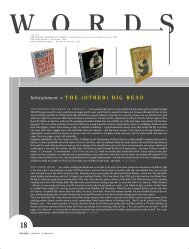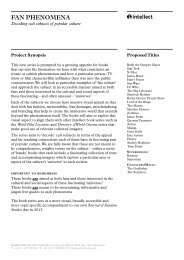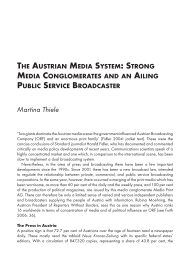Anthem - Intellect
Anthem - Intellect
Anthem - Intellect
You also want an ePaper? Increase the reach of your titles
YUMPU automatically turns print PDFs into web optimized ePapers that Google loves.
Signifying Europe<br />
(1) In the discussion at the ‘What Story Should Europe Tell’ website mentioned<br />
in Chapter 6, it was the anthem that sparked the whole debate. The administrator<br />
initiated the debate by asking if the anthem could be played at European sports events<br />
such as the EuroCup or Champion’s League. The critical user Gheryando found this<br />
idea ‘ridiculous’ since this is ‘an artificial anthem’ that may well be used at political<br />
‘meetings, or celebrating important EU dates’, but not otherwise. 423 He argued that<br />
‘a symbol must mean something to people’, but people have little attachment to<br />
European symbols since they have not through a long history been anchored in public<br />
consciousness and memory and thereby linked to collective identity: ‘Most EU symbols<br />
are empty’. His counter-examples were the Portuguese National <strong>Anthem</strong> ‘A Portuguesa’<br />
and the French ‘La Marseillaise’, both of which were linked to historical events of<br />
great and continued importance to the citizens of each country. By comparison, the<br />
European anthem seemed irrelevant to him: ‘What does the “anthem” of EU mean…?’<br />
Therefore, it should not be imposed ‘in all events in Europe’, though it may be useful<br />
to just celebrate important EU dates.<br />
Like ‘Ode to Joy’ in its slow Karajan adaptation from 1972, the British national<br />
anthem ‘God Save the Queen/King’ is of the hymn type, though in triple time. It<br />
has been widely used in other works as well: for instance by Beethoven who in the<br />
early 1800s developed it into a set of piano variations (WoO 78, 1803) as well as<br />
in his battle symphony Wellington’s Victory, or The Battle of Vitoria (op. 91, 1813).<br />
Even if the British and European anthems belong to the same main category of<br />
rather slow and solemn hymns, Beethoven’s ‘Ode to Joy’ actually has more melodic<br />
and rhythmic similarities with the French ‘La Marseillaise’, which is an anthem of<br />
the more energetic march type (and which in turn is also related to the socialist<br />
‘The Internationale’). The melodic structure is more similar, with a rising arch<br />
ending in a fall back to a stable level, as is the march-inviting 4/4 time. This is not<br />
surprising, given its inspiration from songs and marches of the French Revolution.<br />
In the symphony context, it is also performed in a steady quasi march-like tempo,<br />
though its melodic contour is considerably more calm and limited than the bolder<br />
‘La Marseillaise’. In comparison to many European national anthems, ‘Ode to Joy’<br />
seems to present a kind of common denominator: a strict basic melody of folk-like<br />
character, avoiding extravagant embellishments that would bind it to any specific<br />
nation or region. This way, in line with its composer’s intentions, it makes itself<br />
available for representing transnational humanism, and thus for pan-European<br />
unity, even aspiring to universality.<br />
There are various ways for national anthems to solve the linguistic problems that<br />
caused the European anthem to be deprived of its lyrics. There are of course always<br />
immigrant populations that problematise the idea of a dominant national language<br />
everywhere, but also prominently bi- or multilingual nation states such as Belgium,<br />
Finland, Spain or Switzerland still have sung national hymns with lyrics, with varying<br />
182












